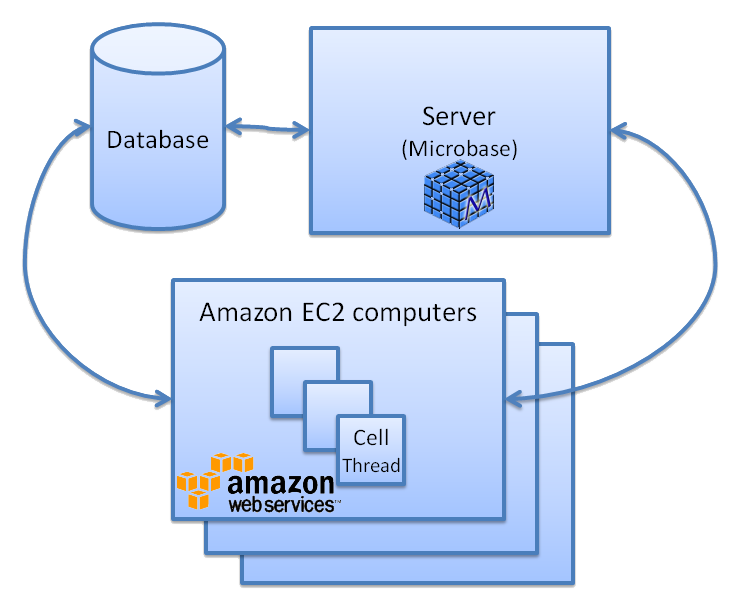Team:Newcastle/Modeling/Population
From 2009.igem.org
TubularWorld (Talk | contribs) |
(→Distributed Computing) |
||
| Line 18: | Line 18: | ||
Due to early versions of our bacterial population simulation program using a lot of CPU time and RAM, we attempted to think of ways to be able to speed up the processing times and expand the simulation. These early simulations were fairly small scale, but as each bacterial cell runs as an independent Thread, every system that we ran it on began to slow down dramatically. | Due to early versions of our bacterial population simulation program using a lot of CPU time and RAM, we attempted to think of ways to be able to speed up the processing times and expand the simulation. These early simulations were fairly small scale, but as each bacterial cell runs as an independent Thread, every system that we ran it on began to slow down dramatically. | ||
| - | Newcastle's School of Computing Science Integrative Bioinformatics Team had been working on a software system for grid computing applications in the scientific field, called | + | Newcastle's School of Computing Science Integrative Bioinformatics Team had been working on a software system for grid computing applications in the scientific field, called <a href="http://madras.ncl.ac.uk/microbase-drupal/"> microbase<\A>. Funded by the BBSRC and the DTI, Microbase has been used in Microbial Genome Comparison and Analysis. Keith Flanagan, a Researcher at Newcastle University and member of the Microbase Project, suggested that Microbase could aid us in the development of a distributed version of our bacterial population simulation. Using Microbase meant that almost all of the programming concerned with the smooth running of our was simple to carry out, and we were easily able to convert our single machine program to a distributed one. |
Using Microbase we are running our simulation on the Amazon Elastic Compute Cloud, a service provided by the e-commerce company Amazon.com, which gives users access to a resizeable large number of powerful machines. Prior to running our simulations using Amazon's computers, we tested our program using some of the machines in some of the University's computer clusters. | Using Microbase we are running our simulation on the Amazon Elastic Compute Cloud, a service provided by the e-commerce company Amazon.com, which gives users access to a resizeable large number of powerful machines. Prior to running our simulations using Amazon's computers, we tested our program using some of the machines in some of the University's computer clusters. | ||
Revision as of 12:27, 21 October 2009
Contents |
Population modelling
One of the models which we are producing is one concerning the population numbers of our bacteria. It looks at how our additions to the DNA may affect the growth of the bacterial population.
This model is currently being implemented in the Java programming language, and connects to other models which we have written in CellML. Due to the design of the program, the team has enlisted the help of some very powerful computers. The next iteration of the program is to use distributed computing and the "Amazon Cloud" to extend the size of the bacterial population.
Visualisation
Alongside the actual simulation we are developing an application to visualise the output of our simulation in a three dimensional environment.
Below is a basic visualisation of one of the early versions of our simulation, where the different states of the bacterial cells are represented by differing colours:

Distributed Computing
Distributed Computing (also known as Cloud or Grid computing) is the use of multiple computing processors, which can be spread around the world to accomplish a single given task. The processes on the machines may also communicate with each other, instead of simply acting independently.
Due to early versions of our bacterial population simulation program using a lot of CPU time and RAM, we attempted to think of ways to be able to speed up the processing times and expand the simulation. These early simulations were fairly small scale, but as each bacterial cell runs as an independent Thread, every system that we ran it on began to slow down dramatically.
Newcastle's School of Computing Science Integrative Bioinformatics Team had been working on a software system for grid computing applications in the scientific field, called <a href="http://madras.ncl.ac.uk/microbase-drupal/"> microbase<\A>. Funded by the BBSRC and the DTI, Microbase has been used in Microbial Genome Comparison and Analysis. Keith Flanagan, a Researcher at Newcastle University and member of the Microbase Project, suggested that Microbase could aid us in the development of a distributed version of our bacterial population simulation. Using Microbase meant that almost all of the programming concerned with the smooth running of our was simple to carry out, and we were easily able to convert our single machine program to a distributed one.
Using Microbase we are running our simulation on the Amazon Elastic Compute Cloud, a service provided by the e-commerce company Amazon.com, which gives users access to a resizeable large number of powerful machines. Prior to running our simulations using Amazon's computers, we tested our program using some of the machines in some of the University's computer clusters.
Code
Due to the complexities of running the model, as it is designed for distributed systems, the code for our population simulation model is available on request. Please email one of our advisors, Morgan Taschuk, for more information.
Pseudo code
Please click here to see some 'pseudo code' which explains the inner workings of our population simulation.
References
External links
- [http://aws.amazon.com/ec2/ Amazon Elastic Compute Cloud]
- [http://madras.ncl.ac.uk/microbase-drupal/ Microbase]
News
Events
- 20 – 21 June 2009 - Europe workshop (London)
- 23 – 24 June 2009 - UK iGEM meetup (Edinburgh)
- 23 October Practice Presentation (Newcastle)
- 23 October T-shirts are ready
- 27 October Practice Presentation (Sunderland)
- 27 October Poster is ready
- 30 October – 2 November 2009 - Jamboree (Boston)
Social Net
- Newcastle iGEM Twitter
- [http://www.facebook.com/home.php#/group.php?gid=131709337641 Newcastle on Facebook]
- [http://www.youtube.com/user/newcastle2009igem Newcastle Youtube Channel]
 "
"

